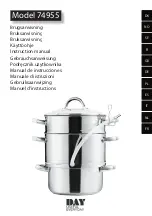
6
and the pressure intensity indicator to make sure that all of the 3 components spring. Clean the apertures
in the nut of the operating valve and install the operating valve back into the lid of the pressure cooker.
Lock against accidental opening
Prevents accidental opening of the pressure cooker before all steam has escaped from the vessel and
pressure has dropped entirely.
Pressure indicator
The pressure intensity indicator shows the current pressure in the vessel. If the indicator is inserted inside
the operating valve, there is no operating pressure in the vessel. If the pressure intensity indicator shows
a red ring, the operating pressure in the vessel is higher than permitted; in this case, immediately reduce
the heat output to minimum and if the red ring remains in the upper position even after reducing the heat
output, immediately turn off the heat source and remove the pressure cooker from the heat.
PRACTICAL HINTS
ALWAYS USE AN APPROPRIATE SIZE OF COOKING RANGE OR FLAME FOR COOKING.
The diameter of the cooking range must be identical or smaller than the diameter of the bottom of the
pressure cooker! Flames must never expand beyond the bottom of the pressure cooker. Use the dispenser
net or cooking range when cooking on gas.
Make use of the heat retaining properties of the three-layer sandwich bottom. Switch the heat off in
advance before the end of cooking. Thanks to the three-layer sandwich bottom, the accumulated heat
energy is transferred into the pressure cooker even after the heat has been switched off .
The vessel of the pressure cooker may also be used without the lid as a traditional pot for cooking meals
on the cooking range.
NOTICE
If a
large amount of steam
escapes from the pressure cooker at the beginning of the cooking process, the
pressure cooker has not been correctly closed. Incorrect closing is usually due to the following:
a) The lid is attached incorrectly – close the pressure cooker again.
b) The pressure regulator is set in the steam release position – adjust it to one of the positions for cooking.
c) The silicone seal is incorrectly positioned in the lid – check its position.
d) The silicone seal is faulty – replace it with a new original TESCOMA seal.
STORAGE, MAINTENANCE AND CLEANING
Lid
DO NOT WASH THE LID OF THE PRESSURE COOKER IN DISHWASHER.
Clean the apertures in the nut of the operating valve by fl ushing them with running water or clean them using
a suitable object.
Clean the safety valve by repeatedly pushing on the centre and lightly pulling the entire valve upwards
under running water.
Do not dismount the safety valve, rotating closure of the lid, grips or any other parts of the lid.
ALWAYS STORE THE PRESSURE COOKER WITH THE LID UNATTACHED.
Summary of Contents for Ultima 4 I
Page 1: ......
Page 2: ......
Page 3: ......
Page 4: ......
Page 88: ...84 ULTIMA 0 15 0 40 0 65 0 85 1 05 A IDEALCOOK xxx C D E F G H...
Page 90: ...86 P IDEALCOOK Q R...
Page 91: ...87 a b c d TESCOMA...
Page 92: ...88 TESCOMACLINOX ULTIMA DUO 4 0 6 0 ULTIMA DUO 6 0 4 0...
Page 93: ...89 TESCOMA 2 TESCOMA EN 12778 1 2 3 4 5 6 7 8 9 10...
Page 95: ...91 5 TESCOMA www tescomarussia ru...
Page 96: ...92 Notes Pozn mky Note Notas Notes Anmerkungen Remarques Notatki Pozn mky...
Page 97: ......
Page 98: ......











































